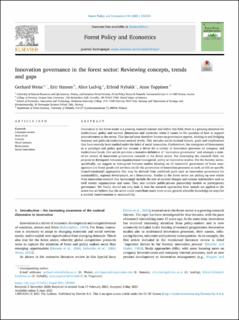| dc.contributor.author | Weiss, Gerhard | |
| dc.contributor.author | Hansen, Eric | |
| dc.contributor.author | Ludvig, Alice | |
| dc.contributor.author | Nybakk, Erlend | |
| dc.contributor.author | Toppinen, Anne | |
| dc.date.accessioned | 2022-01-27T11:26:06Z | |
| dc.date.available | 2022-01-27T11:26:06Z | |
| dc.date.created | 2022-01-12T12:07:54Z | |
| dc.date.issued | 2021 | |
| dc.identifier.citation | Forest Policy and Economics. 2021, 130 . | en_US |
| dc.identifier.issn | 1389-9341 | |
| dc.identifier.uri | https://hdl.handle.net/11250/2885378 | |
| dc.description.abstract | Innovation in the forest sector is a growing research interest and within this field, there is a growing attention for institutional, policy and societal dimensions and particular when it comes to the question of how to support innovativeness in the sector. This Special Issue therefore focuses on governance aspects, relating to and bridging business and political-institutional-societal levels. This includes social/societal factors, goals and implications that have recently been studied under the label of social innovation. Furthermore, the emergence of bioeconomy as a paradigm and policy goal has become a driver for a variety of innovation processes on company and institutional levels. Our article provides a tentative definition of “innovation governance” and attempts a state-of-art review of innovation governance research in the forest sector. For structuring the research field, we propose to distinguish between organizational/managerial, policy or innovation studies. For the forestry sector, specifically, we suggest to distinguish between studies focusing on (i) innovative governance of forest management and forest goods and services; on (ii) the governance of innovation processes as such, or (iii) on specific (transformational) approaches that may be derived from combined goals such as innovation governance for sustainability, regional development, or a bioeconomy. Studies in the forest sector are picking up new trends from innovation research that increasingly include the role of societal changes and various stakeholders such as civil society organizations and users. They also include public-private partnership models or participatory governance. We finally should not only look in how far research approaches from outside are applied in the sector but we believe that the sector could contribute much more to our general scientific knowledge on ways for a societal transformation to sustainability. | en_US |
| dc.language.iso | eng | en_US |
| dc.publisher | Elsevier | en_US |
| dc.rights | Navngivelse 4.0 Internasjonal | * |
| dc.rights.uri | http://creativecommons.org/licenses/by/4.0/deed.no | * |
| dc.title | Innovation governance in the forest sector: Reviewing concepts, trends and gaps | en_US |
| dc.type | Journal article | en_US |
| dc.type | Peer reviewed | en_US |
| dc.description.version | publishedVersion | en_US |
| dc.source.pagenumber | 11 | en_US |
| dc.source.volume | 130 | en_US |
| dc.source.journal | Forest Policy and Economics | en_US |
| dc.identifier.doi | 10.1016/j.forpol.2021.102506 | |
| dc.identifier.cristin | 1979333 | |
| cristin.ispublished | true | |
| cristin.fulltext | original | |
| cristin.qualitycode | 1 | |

